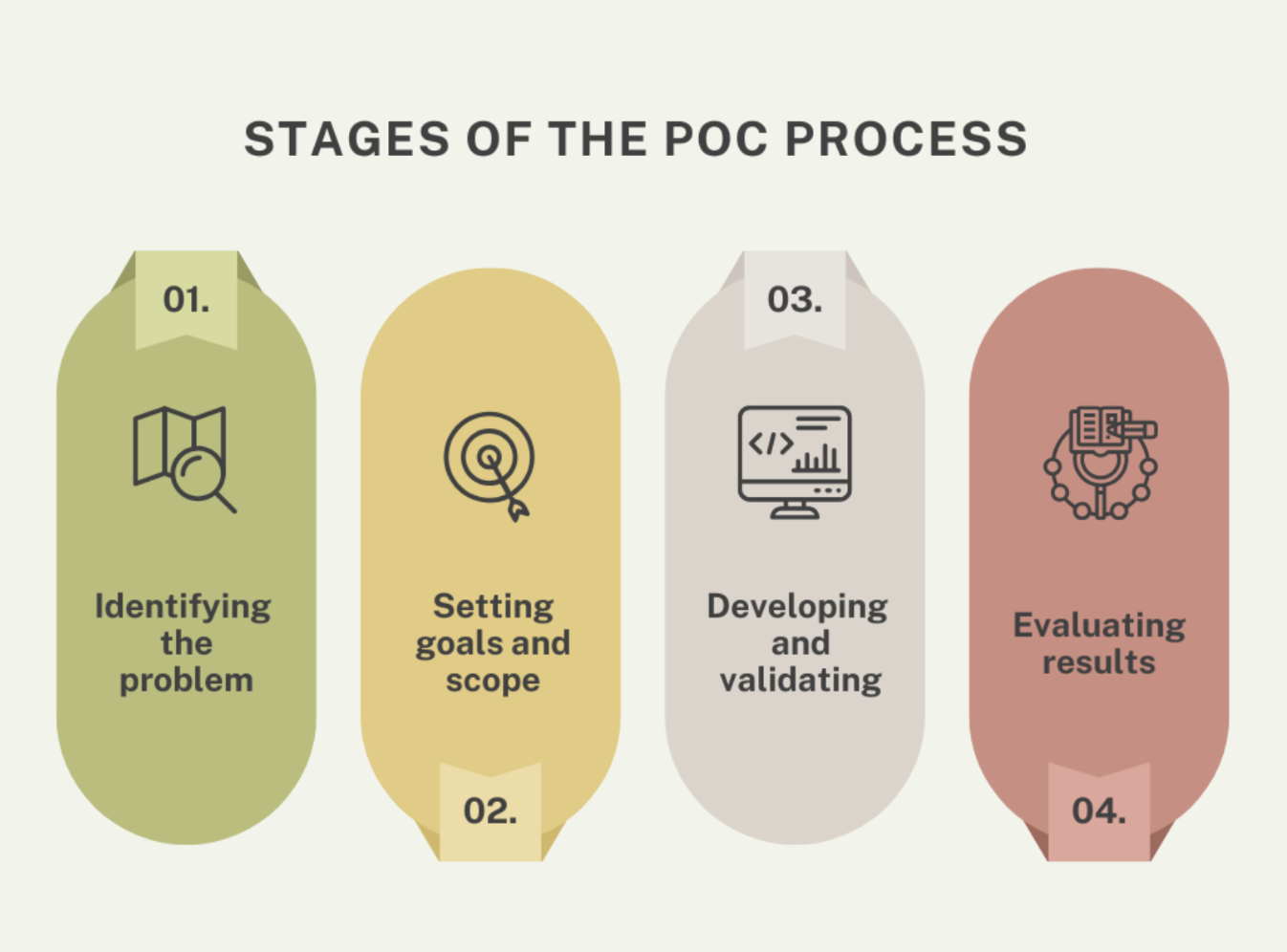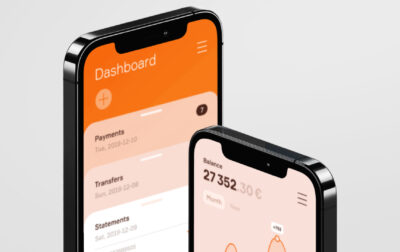Understanding Proof of Concept meaning: Why your project needs it
Intro
Imagine you have a brilliant idea for a new app or tech solution, but you’re not sure if it’ll actually work. You could jump in, spend tons of time and money, and hope for the best. Or, you could take a smarter route: start with a proof of concept (PoC).
A PoC is like a mini-experiment that tests whether your idea is technically feasible. Both SMEs and startups can use PoCs to test ideas before they fully commit. And there are some great examples to prove that.
Proof of Concept Meaning Explained
To begin with, a Proof of Concept (PoC) is a stage in project development that lets you figure out if an idea can actually work. It helps you check if the basic concept is feasible from a technology standpoint before you invest too much into it. The goal isn’t to build the polished product or see the market demand, but to test the idea itself.
In software development, for example, a PoC can confirm if the technology you’ve chosen can handle the features you need. All before starting full-fledged development. In the world of mobile app development, a PoC helps you test if your app’s key features work, saving resources by not building a full solution. It also assesses the scalability, adaptability, and maintainability of your idea, making sure you’re on the right track. Sometimes, you might create more than one PoC to test different parts of a product. This is common when the idea is complex, and each PoC focuses on verifying a specific feature.
A proof of concept is invaluable, no matter you’re a startup or an SME:
Why PoC Is Important for Startups
For startups, a PoC is invaluable because resources are often limited, and the margin for error at this stage is small. A PoC can also show the economic viability of an idea, answering the question: “Will it be worth the investment?” On top of that, a successful PoC proving the idea is realistic and has potential can attract investors early on.
Why PoC Is Important for SMEs
For small and medium-sized businesses, a PoC is a low-risk way to try out new ideas without disrupting day-to-day operations. You can test solutions on a small scale and move forward only with the ones that work. A PoC also helps SMEs stay ahead of the curve, because you can try new ideas and implement them faster than larger companies bogged down by red tape.
In both cases, proof of concept project development acts as a safety net, helping companies confidently move forward with good ideas while reducing the chances of failure.

How PoC Differs from Prototype and MVP
The key difference between a PoC, prototype, and MVP comes down to their goals and the end result shown to project stakeholders. Let’s break it down.
PoC vs. Prototype
Even though PoCs and prototypes can be used as substitutes, they serve different purposes. A proof of concept focuses on whether an idea is feasible and can work as planned, which is especially important in PoC software development. It’s about testing the core concept. A prototype, however, is an initial version of a product that demonstrates its design, usability, and functionality. It helps stakeholders picture the final product and steers the development process.
PoC vs. MVP
While a PoC shows if an idea is technically possible, an MVP (minimum viable product) is a simplified version of the final product ready for real customers to test. Teams usually develop an MVP once they’ve confirmed the idea with a PoC and prototype. The MVP includes key features that draw early users, allowing developers to gather feedback and fine-tune the product before its official launch.
The PoC Process: Key Stages Explained
When building a PoC, there are several important steps you go through to test if your idea has legs before committing to the full project. Here’s a breakdown of these key stages.
1.
Stage 1: Identifying the Problem or Opportunity
The first step is to clearly define the problem your idea is solving or the opportunity it’s addressing. This is the stage where you focus on understanding the core pain points, the potential value your solution can deliver, and its relevance to your target audience. The goal here is to align everyone on the purpose of the PoC and ensure that the development team fully understands the “why” behind the project.
2.
Stage 2: Defining PoC Goals and Scope
Once the problem or opportunity has been identified, the next step is to properly define the goals and scope of the proof of concept. This is essential to ensure the PoC stays focused and avoids turning into a full-scale project. The key is to validate only the truly uncertain aspects of the concept while excluding anything that doesn’t require verification.
Figure out the key questions your PoC needs to answer. What aspects of the idea are still unproven and need to be checked? Are there any technical challenges or risks that must be tested? What is the minimal set of features needed to prove feasibility?
3.
Stage 3: Developing and Validating the PoC
Here, the initial version of the idea is developed. You check if it aligns with your goals and see if it actually works. This is where feedback from your team and other stakeholders comes in handy to make important tweaks. This stage of proof of concept software development is all about validating the technical side of things and making sure the concept is feasible.
4.
Stage 4: Evaluating Results and Making Decisions
Finally, the moment has come to look at the results of all the feedback collected. Does your idea actually work? If it does, then you figure out the next steps to move forward. If not, you take a step back, see where things went wrong, and decide whether it’s time to pivot or make changes before moving ahead.
Validate your idea with confidence!
Examples of Proof of Concept Software Development
Companies in industries like fintech, healthcare, and entertainment often start with proof of concept software to check if their concepts are feasible. Here are three areas of PoC uses and how proof of concepts can verify ideas, making sure they’re worth it.
Crypto Mining Platform For Gamers
In this proof of concept example, our client, a fintech company Gaimin, wanted to validate their idea of a platform for passive crypto mining. It was targeted at gamers with high-powered computers. The app would track mining activity and reward users with points that could be converted to cryptocurrencies.
Our team developed a PoC desktop app for Ethereum mining and point assignment within two weeks. This proof of concept helped Gaimin secure their first investment round. With funding in place, they proceeded to full-scale development of the platform – with our developers at hand.
Celebrity Messaging App for Fans
Here, Supercan, a startup, wanted to create an app that lets users connect with their favorite celebrities, athletes, and rock stars. The app needed features like live messaging, video editing, and payment options for personalized video content.
Our team built a PoC for live messaging in just two days during a workshop with the back-end team. This proof of concept validated the app’s core functionality and helped streamline further development. Despite challenges, like finding a way to bypass marketplace payment fees, Supercan was successfully launched on both iOS and Android.

3 Reasons Why Proof of Concept Is Worth It
To sum up the key points, a proof of concept offers valuable insights to help guide your project in the right direction. Here are the top three reasons it’s beneficial.
1. Validating Feasibility
A proof of concept in software development helps you test if your idea will work, catching potential issues early. It lets you experiment with different technologies to find the best fit for your project, giving you a solid foundation for your product’s roadmap.
2. Reducing Risks and Saving Resources
A proof of concept software tests your architecture, technologies, and approaches before fully committing. This helps you avoid costly mistakes in time, money, and effort, as well as ensures you’re on the right path without jumping in too soon.
3. Building Confidence with Clients and Investors
Sometimes, you need to validate your idea with key clients or investors to gain their confidence. A PoC demonstrates your idea’s feasibility, proving that their resources will be well-spent. It builds trust, reduces risks, and makes it easier to secure further support.
Conclusion
A proof of concept (PoC) is not just a step in project development—it’s a strategic tool that saves time, resources, and effort while mitigating risks. By focusing on validating the most uncertain and critical aspects of an idea, a PoC ensures that your project is built on a solid foundation of feasibility and practicality.
For startups, a well-executed PoC can secure investor confidence and demonstrate the economic viability of innovative ideas. For SMEs, it provides a low-risk way to experiment with new solutions without disrupting core operations. Across industries, from fintech to healthcare, proof of concept software development allows businesses to make informed decisions, ensuring they move forward with confidence and clarity.
By partnering with Touchlane, you gain access to industry experts who can help you build a robust PoC, avoid costly mistakes, and ensure your project is set up for success from the very beginning. Contact us now to get started.
RELATED SERVICES
MOBILE BANKING SOFTWARE DEVELOPMENT
One of the best examples of staff augmentation cooperation model, where our unmanaged team of experienced iOS, Android and QA engineers has completely reworked and significantly expanded mobile application of one of the leading Finnish banks.
One of the best examples of staff augmentation cooperation model, where our unmanaged team of experienced iOS, Android and QA engineers has completely reworked and significantly expanded mobile application of one of the leading Finnish banks.
We Cover
- Design
- Development
- Testing
- Maintenance













